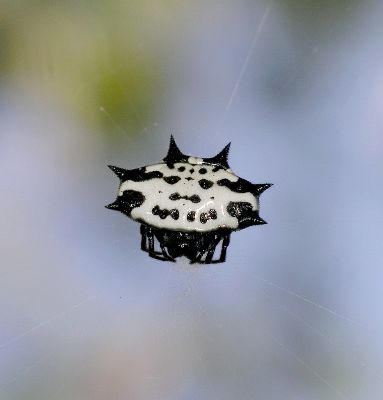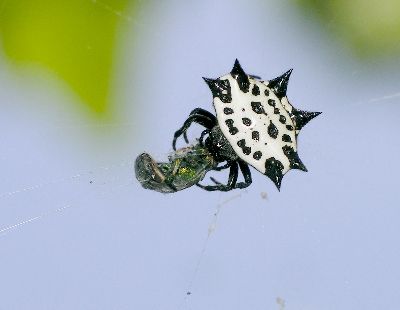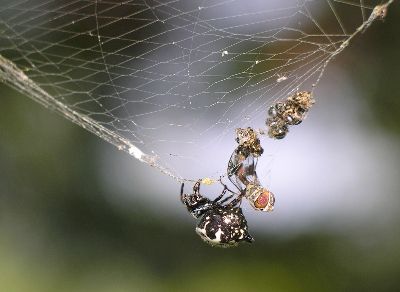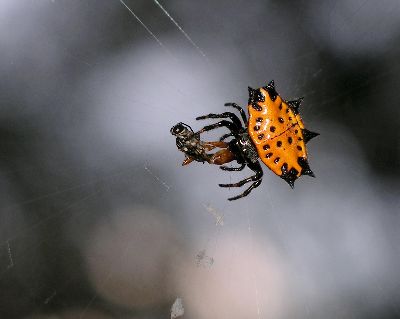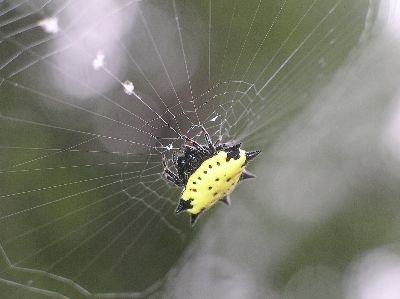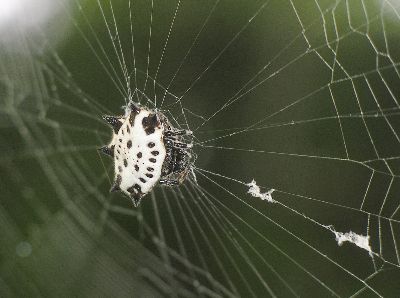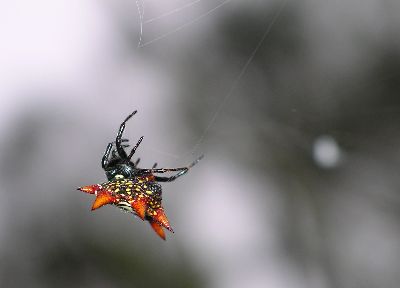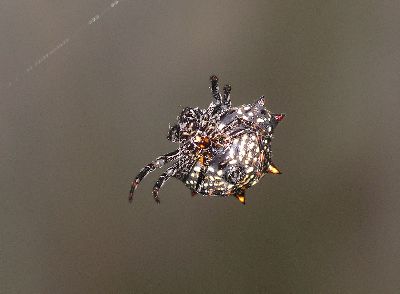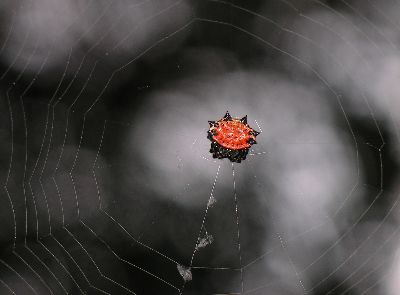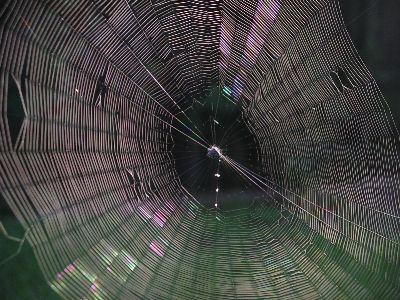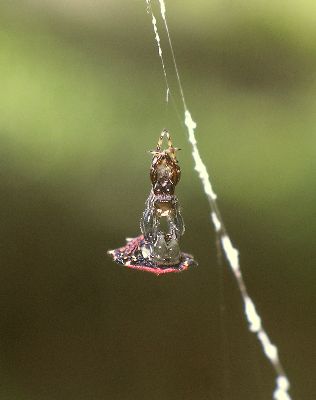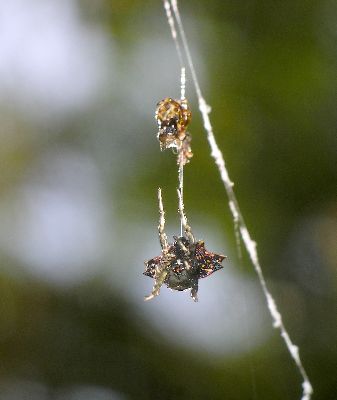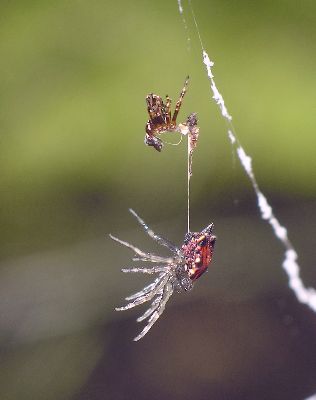The images presented in these galleries are reductions of photos taken by Valerie with a Pentax Optio 450 digital camera. The compression has been increased to 80% (100%=no compression) and the dimensions reduced in order to save bandwidth and facilitate page loading. The information below each image gives the size in pixels and kilobytes of the original file as well as the title by which to request the larger version. All of the original files are in jpeg format, most at about 95% compression, and are suitable for printing, desktop wallpaper, or detailed study. While the images here are free for the taking (right click - save as; do not link to these images directly), the larger versions are also available by sending a request to Valerie via . The frames around the gallery photos are not part of the same file and are only for presentation on this site.
Although the photos are free to use, they are copyrighted by LARVALBUG and remain the property of the owners of this site. We request that any public use of these images be accompanied by a credit to LARVALBUG.COM and, when appropriate, a link to our site (<a href="http://www.larvalbug.com/">LARVALBUG</a>). Commercial use of the large files can be arranged for a modest fee.
To request larger files or ask any questions please send an e-mail to Valerie at .
|
|
Spiny-Backed Orb Weaver (Gasteracantha cancriformis). A strangely shaped tropical spider species that comes in a variety of colors, found throughout the southern United States.
The classic pose in which spiny-backed orb weavers are usually found. They build their webs in open areas and remain visible during the day. Their eyesight is poor and they remain in their webs even when approached or disturbed. Most of the individuals shown here are female, with the males being smaller and less noticeable. In fact, I'm not sure if I've ever seen one, unless some of the smaller spiders that appeared to be immature were in fact males. The females are about 1/2 inch wide when fully grown.
Because they like to build their webs in insect flyways, spiny-backed spiders can frequently be seen feeding on their catch. This one is eating a metallic green bee.
The prey on which this spider is feeding is unidentifiable. Although spiny-backed spiders come in a variety of colors, basic white with black spines is the most common form in our Austin, Texas, gardens.
These spiders are almost constantly rebuilding their webs, which they do whenever damages make the web less efficient as a trap. Sometimes, though, the number of insects flying into the web overwhelms the housekeeper and the web can get pretty messed up. This spider had so much in her larder that she hadn't had time to make repairs.
This is the orange form of the spiny-backed orb weaver. Although I hadn't previously seen this color in our yard, during the summer of 2004, several took up residence. The prey in this case is a small ichneumon wasp.
Another color form is shown here, with a yellow abdomen. I've only seen one individual of this hue and it was at Zilker Gardens here in Austin. The spider made her web above a path and was rather difficult to observe because of the height. I watched her building her web one morning and ended up with a sore neck.
Once a spider has established its web, it can be found in the same location for up to a couple of weeks. Because I knew where this yellow spider was, I could check on it whenever I visited Zilker Gardens. In this photo, it had just finished rebuilding its web. The last thing it added was the line of silk tufts that lead to the center. These must almost certainly be meant to attract insects as the spiders often hold the end of the line much like a fisherman with a lure.
Another view showing the line of silk tufts that the spiders add to their webs. While a line of the tufts almost always leads to the very center of the web, the locations of additional ones throughout the rest of the web varies. Often they are on the main guy strands. Sometimes they are also on the outer edges of the web or in a loose spiral towards the center.
Yet another color variant of the spiny-backed orb weaver. I've never seen this attractive form (with large red spines) in our area of Texas, but they are very common in southern Florida, which is where this photo was taken. Although it was February, these spiders, as well as other orb weavers, were just as active as in the summer.
Sometimes spiny-backed spiders build their webs low to the ground. I have frequently blundered into them when I'm not paying attention to where I'm going. However, they are just as likely to be located about 7 to 8 feet up, usually attached to tree branches. It is interesting to watch them creating their webs against the sky.
A side view of the red-spined form of the spiny-backed spider. Because they rebuild their webs so frequently, these spiders are generally more active than one would expect from a predator that waits for prey to come to it. If the web is several feet off the ground and the wind is blowing, it is quite a challenge to try to photograph the spider as it moves about depositing silk.
Ventral view of a spiny-backed orb weaver. This one was building its web in the back corner of our yard and so offered an excellent view and sheltered area. The silk is coming out of the spinnerets, and the spider manipulates it into place with its back legs. Once the spider has constructed the main guy lines to its web, it spends a long time creating the spiral webbing, spacing the silk very close together. It always starts from the outside and works its way in.
Another ventral view of the same spider. Spiny orb weavers have large jaws for their size. Their strange shape makes them about the most un-spiderlike looking arachnids that spin webs. In spite of their cryptic shape and careful placement of webs, they still occasionally fall prey to other predators, such as birds and wasps. I once watched a paper wasp fly right into the center of an adult spider's web and attack its inhabitant. The two fell to the ground below the web and continued struggling for a few minutes. The spider lost and the wasp ate the outer bits of its victim until the remains were small enough for the insect to get airborne and carry it back to the nest.
I was up on our roof to trim branches when I found this little spider in the overhanging branches of a live oak tree. Young spiders make proportionally small webs, but they contain all the elements of an adult web, including the little silk tufts.
The web of the spiny-backed orb weaver is one of the most beautiful in our area. Although I find a lot of these webs, they are rarely in the right position to photograph well, so it was a pleasant surprise to see the early morning sun on this one. The rainbow colors are created when the light hits the myriad tiny beads of clear sticky liquid on the silk strands. This view gives an idea of the complexity of these webs, with their intricate and closely spaced spiral. This web spanned nearly four feet, with the central spiral measuring about two feet across.
This is a head-on view of a molting spiny-backed orb weaver. The spider is very young and only about 1/4 of an inch wide. Because it was so small, I was at first unsure of what I was seeing. It looked simply like a dead spider hanging by its legs and there appeared to be something wrong with its head.
Shortly after I found this spider, I realized that it must be molting, but I could not make out any of the details. Not only was the arachnid very small, but it was blowing about in the morning breeze. The large jaws are very evident in this side view.
Another almost head-on view taken only a minute or so after the first photo. When I first saw the spider, it had already split its old skin and its abdomen and top of its head had emerged. Shortly after, the fangs pulled free, followed by the legs.
In this image, the spider is almost completely free of its old skin. Orb weaver spiders always molt upside-down, letting gravity help to pull them out. All arthropods have to periodically molt, or shed their outer skin, in order to grow. The new skin is soft at first, then later hardens as it dries.
When orb spiders molt, they attach a safety line of silk to their web so that they won't fall when they finish emerging. In this case, the web was almost gone and only a sturdy strand remained. It would not surprise me if the spider intentionally did this so that it could hang freely and dry out.
Because the silk attachment line extends from the spinnerets, the old skin is caught on it and remains dangling above the spider. The whole process of molting took only minutes, and at this point the spider is helpless, simply blowing about in the breeze and flexing its legs so that the new skin can dry properly.
Like an aerial ballet dancer, the little spider continued to move its legs into various symmetrical positions. The new skin will dry larger than the old one because the spider pumps fluid into its outer extremities, much the same as when butterflies pump up their wings after emerging from their chrysalis.
|
